2020 Activity Report
March Activity Report
March 2021
Global Japan Office Coordinator
AHN Soyon
The purpose of studying Japanese is different for each person. Some students study to get good scores on the Language Proficiency Test, while others study in order to be able to speak freely with Japanese people. Students who aim the mutual good understanding are diligent in listening and speaking skill up training, and also have a strong desire to speak in Japanese. It is the most fun and effective activity for them to have language exchange lessons with Japanese students, but it is regrettable that almost no Japanese students come to Korea due to the prolonged COVID-19 pandemic. Therefore, GJO decided to provide a source which is available to enjoy.
I created an exercise for beginners so that Korean learners can practice conversation in pairs. Since many students have trouble with communicate numbers, we made students to speak and listen to “date and time” with a theme of “Schedule” many times. Then I tried to expand the adjective vocabulary with my impression of the day. After completing the exercises provided by the GJO, they will practice sharing their own past and future. Now they can feel the fun of speaking about themselves in Japanese.
Instead of just simple drills, I made an creative exercise to stimulate students' imagination by presenting pictures rather than in letters, so that students could choose appropriate words from their own vocabulary to speak. It is a practice to explain the presented picture using adjectives and recommend it to the others. Since there are no fixed vocabulary, they can expect the effect of vocabulary expansion by searching for the vocabulary they want to speak.
The COVID-19 pandemic has almost stopped exchange meetings and language exchange lessons, which were the most enjoyable activities for university students studying foreign languages, but the GJO Seoul Office will continue to support students supplying enjoyable learning activities.
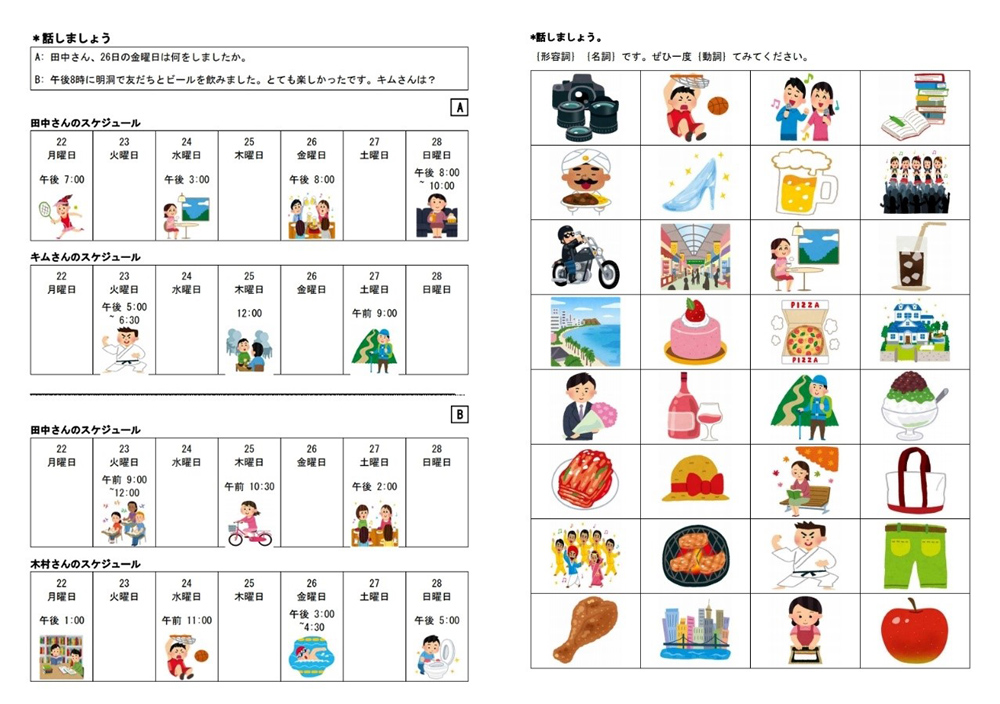
February Activity Report
February 2021
Global Japan Office Coordinator
AHN Soyon
The other day, I was invited to an online meeting of the Japanese language teachers association to which my friend belongs. The Association of Japanese Teachers includes Korean Japanese teachers as well as Japanese teachers living in Korea. It was a good opportunity for me to hear about the field work of people who are active in various organizations and actually provide education in the field, so I participated in it. The level of learning, learning goals, age, and occupation of the learners they were teaching varied, and I heard the opinions of many experts from various fields. Among them, the most impressive story was about “learning continuity”. What is the role of a teacher in making students continue their studies without giving up? In general, reasons for abandoning learning are problems with learning, such as “can’t memorize kana” “Difficult to “Tekei (te-form)”” and “the difficulty of humble language”, all which can be overcome by the development of teaching methods. But how should we deal with psychological problems such as “I can’t keep up with the class by myself.” and “The teacher doesn’t look at me.”? One of the important roles of teachers is ted, and encouraging them to cheer up even if they can’t keep up with classes. As a matter of fact, the ongoing covid-19 pandemic has made it impossible for many to study abroad and students o eliminate psychological anxiety by showing interest in each student to see if they are alienathave expressed a declining motivation, making this meeting very useful for myself.
The Seoul Office has focused more on activities that students can do under conditions they have never experienced before than on providing support for continuous learning. From now on, I would like to listen to the students’ anxieties, think about what I can do to eliminate them, and support them so that they can continue learning.
January Activity Report
January 2021
Global Japan Office Coordinator
AHN Soyon
The GJO Seoul office is conducting informative talks about studying abroad. The main contents of the talks used to be mainly about living in Japan and the curriculum, but its contents changed a year ago when the corona virus began to spread. There has been an increase in the number of consultations about studying in Japan itself, ranging from worries about whether to proceed with studying in Japan or not, concerns about living abroad, and visa problems due to entry restrictions. In fact, the number of foreign students has decreased, and I often see foreign students who have returned to their home countries.
In the past, the EJU (Examination for Japanese University Admission for International Students) and Japan Study Fair, organized by JASSO (Japan Student Services Organization) and the Korean-Japanese Association, were held regularly in Korea, but after the spread of the coronavirus, they were held online using Zoom. Students who are considering studying abroad are invited to participate in the fair because they can receive advice from overseas study specialists.
If the students have no choice but to give up studying abroad, there is a talk about a course in Korea that is as effective as studying abroad in Japan. When I was consulting with them, I thought it was necessary to devise a program structure that would allow students who were planning to study abroad to continue studying Japanese in Korea efficiently.
December Activity Report
December 2020
Global Japan Office Coordinator
AHN Soyon
A year has passed since the new coronavirus started to spread. This unprecedented situation has forced the GJO Seoul office to operate in an entirely new way.
I have been trying to do my best within the Korean government’s epidemic prevention system, but I always felt that I was not doing enough. However, Ms. Yagi of Belgrade GJO proposed a GJO Coordinator Exchange Meeting, and I was happy to participate in it. I asked them what kind of activities they are involved in, and they gave me ideas for fun online Japanese language education. I was especially impressed with the music and singer-themed classes, so I would like to use something similar in the Seoul office. Recently, it has become common for Korean idol singers to release Japanese versions of Korean songs, so I am thinking of using both versions for Japanese language education.
Even if the situation faced by each country differs, all share the fact that they are navigating difficult times. I have learned about the situation of each country through activity reports and information exchange, so if I come upon an idea, I would like to introduce it not only to the Seoul office but also share it with the others.
November Activity Report
November 2020
Global Japan Office Coordinator
AHN Soyon
Until last month, the number of people infected with the new coronavirus was two digits, but in November, the number rapidly increased to three digits. That’s why the South Korean government is raising the alert level and strongly advising people to refrain from going out. So, we in the Seoul office decided to continue our online activities and suspend the offline ones. Since Japanese language schools may close according to the alert level, we have decided to actively respond to questions from Japanese language learners who find themselves in trouble.
I used various functions of ZOOM to explain vocabulary and grammar. I explained the vocabulary and grammar in more detail than the text, and in addition to the content of the text, I also added knowledge that would be helpful. After the Q & A session, I asked them to send me a picture of the problem they solved through social media, and I checked what was wrong and what they missed.
One of the students who participated in the study said, ‘The Seoul office’s online Q & A helps you learn a lot. Especially, if you have something you don’t understand, you can always ask questions and get them solved, so you can study by yourself without worries.’
Although the offline world has stopped, I was happy to be able to help Japanese learners through online activities.
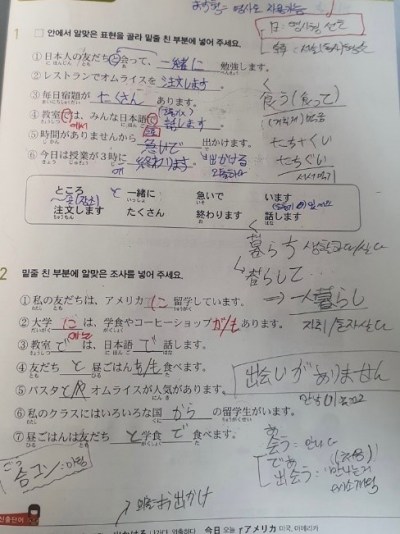
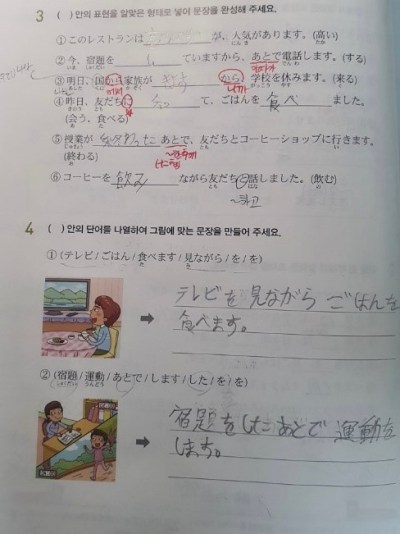
October Activity Report
October 2020
Global Japan Office Coordinator
AHN Soyon
Here at the Seoul Office, we also give language study support. Students studying for the Korean Language Proficiency Test or the Japanese Language Proficiency Test are encouraged to use the text of the reading questions as a study method. First, you write down the text in your notebook, then write the furigana for the kanji without using a dictionary. After that, you translate the text and look up all of the kanji you couldn’t read and make note of the expressions or grammar structures you weren’t familiar with. This way, while only using the material for the reading section, you can master the grammar and vocabulary necessary to pass the test.
If you want to challenge yourself even further, we recommend “reverse translation”. In reverse translation, first a native Korean speaker translates the text from Japanese to Korean, and a week later you translate the same text back into Japanese. Even if you can’t translate the text back to its original word for word, if you can reproduce the same content in your own words, you have succeeded. The reason for the one-week interval is so that the content and grammar of the text is not too fresh in your memory. This way you can see if you truly understand the text you are translating. Also, when you translate from Japanese to Korean or from Korean to Japanese, you can see any habits you have when translating. By comparing the original text with the final translation, you can check the expressions and grammar you are missing from your understanding of the language.
In fact, the effectiveness of this study method proposed by the Seoul Office has been proved through the students’ success in passing their exams and improvements in their writing and translating skills. I feel a sense of gratitude and a sense of responsibility for the students who accept the advice of the Seoul office and study hard.
September Activity Report
September 2020
Global Japan Office Coordinator
AHN Soyon
The Seoul Office provides 'verb vocabulary cards' for Japanese language learners. It can be used to memorize and practice using new vocabulary, and is especially popular among beginners. I have been receiving requests for cards of other lexical categories, so I made nominal adjective cards. On the front side of the card, I wrote down the words with Furigana, and on the back side, I wrote down the meaning of them in Korean and their conjugations. Students learn the meaning by reading the words on the front page, practice using them, and checking the information on the back page to see if they remember the answers correctly. To make the learning process less stressful for the students, I have only made 36 cards a set. This is the number of words that beginners can memorize without getting tired of the drill and practice method. However, you can’t memorize Kanji perfectly just by reading them, so I tell my students to write what they have learned from the cards on a piece of paper by themselves.
As group study has become difficult amidst COVID-19, I hope that these vocabulary cards can be used as a fun method for learning Japanese.
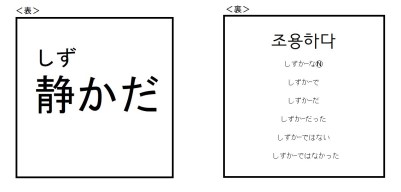
August Activity Report
August 2020
Global Japan Office Coordinator
AHN Soyon
By July, South Korea had limited the number of people infected with COVID-19 to less than 50 per day, and had shifted to a “lifestyle quarantine” system while resuming off-line activities. In August, however, a cluster emerged in the metropolitan area, and the number of cases spiked to three figures a day.
The Central Disaster and Safety Countermeasures Headquarters announced that the social distancing alert level would be raised to 2.5 for the first time in order to prevent the spread of infection. The new measures include broadening the extent of QR code entry/exit list requirements, which was previously limited to Internet cafes and karaoke. Additionally, customers are no longer allowed to eat or drink inside coffee cafe chains and restaurants are only open until 9 p.m.
News and bulletins related to COVID-19 are often announced in Korean, so the GJO Seoul office has been informing foreign students about the newly implemented quarantine system and reinforced measures by e-mail. The Korean government also publishes information on this in many languages, but as this is closely related to our livelihood and affects many people’s lives, I am actively providing information to students and consulting with them if they have any problems. The GJO Seoul office was also preparing to resume off-line activities, so this situation is truly disappointing. I just hope that things will improve as soon as possible.
July Activity Report
July 2020
Global Japan Office Coordinator
AHN Soyon
Although South Korea limits the number of people infected with COVID-19 to less than 50 per day, the Centers for Disease Control and Prevention has recommended to continue following preventive measures against the spread of the virus. These measures aim to realize the prevention of the spread of COVID-19, while still engaging in daily life, economic and social activities. In response to this, many people have begun to gradually return to their daily lives whilst complying with infection control measures.
Hankuk University of Foreign Studies (HUFS) has also began to reopen colloquiums, which had been suspended since the virus outbreak. I was invited to a colloquium, which was held for the first time since the Institute for Humanities and Social Studies of HUFS began its preventive measures. Many precautions were taken before entering the hall, such as keeping records (name, affiliation, contact information, body temperature), taking body temperatures and using alcohol disinfectant. Usually, the participants would shake hands and greet each other, but this year they only greeted each other verbally to avoid contact.I could see that the social distancing slogan “Far in Distance, Close at Heart” established by the Korean Ministry of Health and Welfare was being put into practice.
When I entered the venue, the staff guided me to be seated at a distance of two meters apart from other participants. The door of the hall was left open for ventilation. Everyone who participated in the colloquium kept their masks on for the entire event and the presenter also wore a mask using a microphone with a microphone cover. However, the presentations, questions and answers, and discussions were as enthusiastic as usual.
After seeing the infection preventive measures taken at the Colloquium, I am looking forward to resuming offline activities at the Seoul Office while staying safe and cautious.
June Activity Report
June 2020
Global Japan Office Coordinator
AHN Soyon
I had the opportunity to speak with a professor very interested in Japan-Korea exchange. He launched the “Sejong University Japan Exchange Program and Yokohama National University International Program” at Sejong University in Korea for the first time and has been involved in Japan-Korea exchange festivals for many years. He talked about his experience in exchange meetings aimed at Japanese and Korean university students. We talked in depth about the preparation needed before and after exchange meetings, the purpose of them, as well as how to create an event program. While holding exchange meetings for the sake of language practice can be meaningful, I came to understand that the content of the discussions is just as important. One significant aspect of these meetings is “cultural” exchange. It was mentioned that for cultural exchange, it is necessary to recognize that not only ancient traditions but also current ones are part of the culture, and to set a wide range of topics related to different eras in time for young participants.
Currently, due to COVID-19, many exchange meetings have been canceled around the world and nobody knows when we will be able to resume offline exchange meetings again. Here at the Seoul office, we will do our best to hold safe online exchange meetings under COVID-19 circumstances.
May Activity Report
May 2020
Global Japan Office Coordinator
AHN Soyon
Museums, art galleries and other cultural facilities were temporarily closed as a preventive measure against the new corona virus, and all events aimed at introducing Japanese culture were canceled. Our plan to go to an ukiyo-e exhibition named “Guide to Edo – Hokusai” sponsored by The Japan Foundation was canceled to prevent the spread of the virus. Although this was disappointing as we were looking forward to it, the exhibition was held online instead, and we were able to visit it virtually with the students.
The influence of ukiyo-e can be seen in the works of Dutch impressionist painter Vincent van Gogh, so I thought this exhibition would be a great opportunity to expand our knowledge on Japanese culture within Europe and America. I improvised a guided tour of the exhibition and shared with the students interesting stories surrounding the works. I talked about historical background, such as how ukiyo-e (a genre of Japanese traditional painting) was introduced to Europe and America in the 19th century and how it influenced Western impressionists. Van Gogh’s portrayal of ukiyo-e and his works incorporating ukiyo-e techniques were particularly appreciated by the students. I also talked about the relationship between “Japonism” and ukiyo-e, and how it has lead to today.
The students commented: ‘I have come across ukiyo-e many times before, but I never thought it would be so profound.’ ‘We’ve finally figured out why Hollywood’s Star Wars movies have some Japanese elements here and there.’ and ‘I thought I would only be seeing aspects of Japan, but I feel like I have also traveled to Europe and America.’ I think it was a valuable experience to not only understand Japan within Asia, but also to expand horizons and discover Japan through Europe and America.
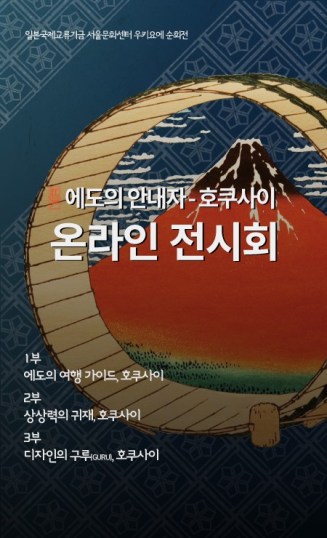
April Activity Report
April 2020
Global Japan Office Coordinator
AHN Soyon
The Japan Foundation Seoul Japan Culture Center holds a Japanese teacher salon once a month. The theme for April was “Learning Design: Incorporating Interaction Learning” a study design/method that combines Korean language classes with Japanese language classes. I participated in the event with the expectation that it could be used as a blueprint for “exchange meetings” and “language exchanges” planned by GJO Seoul Office. It was held online with ZOOM because of the coronavirus.
The teacher who taught me this time was a Japanese teacher at a university in South Korea, and the study design and examples she taught me were very effective and fun activities for improving language abilities that could be used at the GJO Seoul Office exchange meetings and language exchanges. These are not activities that end in a short period of time, but rather make up a program in which we can continue to interact with each other over a long period of time, so we can get to know each other more deeply.
At the moment, everything has been stopped due to the coronavirus, but I hope that the day will come soon when the pandemic will come to an end and Japanese and Korean university students will be able to gather for exchange meetings and language exchanges.
